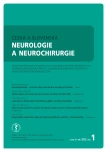Carpal Tunel Syndrome and Neurosurgeon – Experience after 2,200 Surgeries
Authors:
Miroslav Vaverka
Authors‘ workplace:
Neurochirurgická klinika, LF UP a FN Olomouc
Published in:
Cesk Slov Neurol N 2012; 75/108(1): 44-50
Category:
Original Paper
Overview
Objective:
The author’s experience with more than 2,200 open surgical releases of carpal tunnel syndrome with no serious complications are presented and compared with modern endoscopic methods.
Patients and methods:
Over 13 years, one surgeon had operated all patients using the same surgical technique. Patients from the last two years were followed-up prospectively, evaluating anatomical variants and all kinds of complications.
Results:
In 221 patients 299 surgeries were performed, 89 on the right side, 54 on the left and 78 on both hands (35.3%). Surprisingly positive results were also achieved in a subgroup of 87 seniors over 65 yrs. There was no injury to the median nerve or branches, postoperative hematoma or infection was not present. An important surgical variant was identified in 3 cases (1%), a minor anatomical change in 10%. Reoperation for scarring was needed in two cases (0.7%), with good final results. After 6 months, grip dysfunction and pillar syndrome were present in 1% of cases only, tendovaginitis of flexor pollicis longus was also treated in 1%.
Conclusion:
Open surgical approach – mini-open technique – still offers excellent results with minimal number of complications and minimal financial expenses.
Key words:
carpal tunnel syndrome – open surgery
Sources
1. Haase J. Carpal tunnel syndrome – a comprehensive review. In: Schramm J (ed). Advances and technical standards. Vol. 32. New York, Wien: Springer 2007 : 175–249.
2. Schmidek AK, Winograd JM. Surgical management of median nerve compression at the wrist by open technique. In: Schmidek and Sweet’s Operative neurosurgical techniques. Vol I. 5th ed. Philadelphia: Saunders 2006 : 169–173.
3. Pechan J, Kříž K. Akroparestesie a komprese nervů na horních končetinách. Praha: Avicenum 1975.
4. Kříž K, Pechan J. Patogeneze a léčba akroparestesií horních končetin. Praha: SZdN 1961.
5. Stancić MF, Mićović V, Potocnjak M. The anatomy of the Berrettini branch: implication for carpal tunnel release. J Neurosurg 1999; 91(6): 1027–1030.
6. Kanta M, Ehler E, Kremláček J, Řehák S, Laštovička D, Adamkov J et al. The potential benefit of intracarpal pressure measurement in endoscopic carpal tunnel syndrome surgery – an analysis of EMG findings and pressure values. Acta medica (Hradec Králové) 2009; 52(2): 63–68.
7. Natale M, Spennato P, Bocchetti A, Fratta M, Savarese L, Rotondo M. Ulcerative and mutilating variant of carpal tunnel syndrome. Acta Neurochir 2005; 147(8): 905–908.
8. Lazaro RP. Neuropathic symptoms and musculoskeletal pain in carpal tunnel syndrome: prognostic and therapeutic implications. Surg Neurol 1997; 47(2): 115–119.
9. Kurča E. Syndrom karpálného tunela. Cesk Slov Neurol N 2009; 72/105(6): 499–510.
10. Greenberg MS. Median nerve entrapment. In: Handbook of neurosurgery. 5th ed. New York: Thieme 2001 : 535–539.
11. Russell BS. Carpal tunnel syndrome and the “double crush” hypothesis: a review and implications for chiropractic. Chiropr Osteopat 2008; 16 : 2.
12. Nazzi V, Franzini A, Messina G, Broggi G. Carpal tunnel syndrome: matching minimally invasive surgical techniques. J Neurosurg 2008; 108(5): 1033–1036.
13. Oertel J, Schroeder HW, Graab M. Dual-portal endoscopic release of the transverse ligament in carpal tunnel syndrome: results of 411 procedures with special reference to technique, efficacy and complications. Neurosurgery 2006; 59(2): 333–340.
14. Serra L, Panagiotopoulos K, Bucclero A, Mehrabi FK, Pescatore G, Santangelo M et al. Endoscopic release in carpal tunnel syndrome: analysis of clinical results in 200 Cases. Minim Invasiv Neurosurg 2003; 46(1): 11–15.
15. Filippi R, Reisch R, El Shki D, Grunert P. Uniportal endoscopic surgery of carpal tunnel syndrome: technique and clinical results. Minim Invasiv Neurosurg 2002; 45(2): 78–83.
16. Keiner D, Gaab MR, Schroeder HWS, Oertel J. Long-term follow-up of dual-portal endoscopic release of the transverse ligament in carpal tunnel syndrome: an analysis of 94 cases. Neurosurgery 2009; 64(1): 131–138.
17. Hwang PY, Ho CL. Minimally invasive carpal tunnel decompression using Knifelight. Neurosurgery 2007; 60 (Suppl 1): ONS162–ONS169.
18. Mackinnon SE. Featured subject: Peripheral Nerve. Surg Neurol 1997; 47 : 105–114.
19. Stütz NM, Gohritz A, Novotny A, Falkenberg U, Lanz U, Schonhoven J. Clinical and electrophysiological comparison of different methods of soft tissue coverage of the median nerve in recurrent carpal tunnel syndrome. Neurosurgery 2008; 62 (Suppl 1): 194–200.
20. Huang JH, Zager EL. Mini-open carpal tunnel decompression. Neurosurgery 2004; 54(2): 397–400.
21. Proubasta IR, Lluch A, Lamas CG, Oller BT, Itatre JP. “Fat pad“ and “little finger pulp“ signs are good indicators of proper release of carpal tunnel. Neurosurgery 2007; 61(4): 810–812.
22. Assmus H. Tendovaginitis stenosans: a frequent complication of carpal tunnel syndrome. Nervenartzt 2000; 71(6): 474–476.
23. Harada K, Nakashima H, Teramoto K, Nagai T, Hoshino S, Yonemitsu H. Trigger digits – associated carpal syndrome: relationship between carpal tunnel release and trigger digits. Hand Surg 2005; 10(2–3): 205–208.
Labels
Paediatric neurology Neurosurgery NeurologyArticle was published in
Czech and Slovak Neurology and Neurosurgery

2012 Issue 1
Most read in this issue
- Vertebroplasty – Treatment Option for Structurally Insufficient Vertebras
- Carpal Tunel Syndrome and Neurosurgeon – Experience after 2,200 Surgeries
- Guillain-Barré Syndrome in a Patient with a Renal Carcinoma – a Case Report
- Guidelines for Pharmacotherapy of Neuropathic Pain
